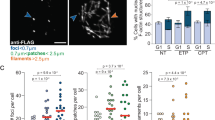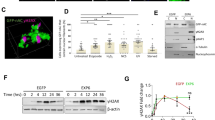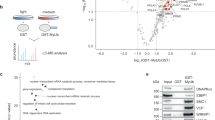Abstract
Actin is abundant in the nucleus and has been implicated in transcription; however, the nature of this involvement has not been established. Here we demonstrate that β-actin is critically involved in transcription because antibodies directed against β-actin, but not muscle actin, inhibited transcription in vivo and in vitro. Chromatin immunoprecipitation assays demonstrated the recruitment of actin to the promoter region of the interferon-γ-inducible MHC2TA gene as well as the interferon-α-inducible G1P3 gene. Further investigation revealed that actin and RNA polymerase II co-localize in vivo and also co-purify. We employed an in vitro system with purified nuclear components to demonstrate that antibodies to β-actin block the initiation of transcription. This assay also demonstrates that β-actin stimulates transcription by RNA polymerase II. Finally, DNA-binding experiments established the presence of β-actin in pre-initiation complexes and also showed that the depletion of actin prevented the formation of pre-initiation complexes. Together, these data suggest a fundamental role for actin in the initiation of transcription by RNA polymerase II.
This is a preview of subscription content, access via your institution
Access options
Subscribe to this journal
Receive 12 print issues and online access
$209.00 per year
only $17.42 per issue
Buy this article
- Purchase on SpringerLink
- Instant access to full article PDF
Prices may be subject to local taxes which are calculated during checkout







Similar content being viewed by others
References
Pederson, T. & Aebi, U. Actin in the nucleus: what form and what for? J. Struct. Biol. 140, 3–9 (2002).
Bettinger, B. T., Gilbert, D. M. & Amberg, D. C. Actin up in the nucleus. Nature Rev. Mol. Cell Biol. 5, 410–415 (2004).
Sahlas, D. J., Milankov, K., Park, P. C. & De Boni, U. Distribution of snRNPs, splicing factor SC-35 and actin in interphase nuclei: immunocytochemical evidence for differential distribution during changes in functional states. J. Cell Sci. 105, 347–357 (1993).
Nakayasu, H. & Ueda, K. Association of rapidly-labelled RNAs with actin in nuclear matrix from mouse L5178Y cells. Exp. Cell Res. 160, 319–330 (1985).
Kimura, T., Hashimoto, I., Yamamoto, A., Nishikawa, M. & Fujisawa, J. I. Rev-dependent association of the intron-containing HIV-1 gag mRNA with the nuclear actin bundles and the inhibition of its nucleocytoplasmic transport by latrunculin-B. Genes Cells 5, 289–307 (2000).
Hofmann, W. et al. Cofactor requirements for nuclear export of Rev response element (RRE)- and constitutive transport element (CTE)-containing retroviral RNAs. An unexpected role for actin. J. Cell Biol. 152, 895–910 (2001).
Percipalle, P. et al. Actin bound to the heterogeneous nuclear ribonucleoprotein hrp36 is associated with Balbiani ring mRNA from the gene to polysomes. J. Cell Biol. 153, 229–236 (2001).
Percipalle, P. et al. Nuclear actin is associated with a specific subset of hnRNP A/B-type proteins. Nucleic Acids Res. 30, 1725–1734 (2002).
Krauss, S. W., Chen, C., Penman, S. & Heald, R. Nuclear actin and protein 4.1: essential interactions during nuclear assembly in vitro. Proc. Natl Acad. Sci. USA 100, 10752–10757 (2003).
Smith, S. S., Kelly, K. H. & Jockusch, B. M. Actin co-purifies with RNA polymerase II. Biochem. Biophys. Res. Commun. 86, 161–166 (1979).
Rungger, D., Rungger-Brandle, E., Chaponnier, C. & Gabbiani, G. Intranuclear injection of anti-actin antibodies into Xenopus oocytes blocks chromosome condensation. Nature 282, 320–321 (1979).
Scheer, U., Hinssen, H., Franke, W. W. & Jockusch, B. M. Microinjection of actin-binding proteins and actin antibodies demonstrates involvement of nuclear actin in transcription of lampbrush chromosomes. Cell 39, 111–122 (1984).
Egly, J. M., Miyamoto, N. G., Moncollin, V. & Chambon, P. Is actin a transcription initiation factor for RNA polymerase B? EMBO J. 3, 2363–2371 (1984).
Burke, E., Dupuy, L., Wall, C. & Barik, S. Role of cellular actin in the gene expression and morphogenesis of human respiratory syncytial virus. Virology 252, 137–148 (1998).
Percipalle, P. et al. An actin–ribonucleoprotein interaction is involved in transcription by RNA polymerase II. Proc. Natl Acad. Sci. USA 100, 6475–6480 (2003).
Fomproix, N. & Percipalle, P. An actin–myosin complex on actively transcribing genes. Exp. Cell Res. 294, 140–148 (2004).
Lessard, J. L. Two monoclonal antibodies to actin: one muscle selective and one generally reactive. Cell Motil. Cytoskeleton 10, 349–362 (1988).
Gimona, M. et al. β-actin specific monoclonal antibody. Cell Motil. Cytoskeleton 27, 108–116 (1994).
Sawtell, N. M. & Lessard, J. L. Cellular distribution of smooth-muscle actins during mammalian embryogenesis: expression of the α-vascular but not the γ-enteric isoform in differentiating striated myocytes. J. Cell Biol. 109, 2929–2937 (1989).
Jackson, D. A., Iborra, F. J., Manders, E. M. & Cook, P. R. Numbers and organization of RNA polymerases, nascent transcripts, and transcription units in HeLa nuclei. Mol. Biol. Cell 9, 1523–1536 (1998).
Philimonenko, A. A., Janacek, J. & Hozak, P. Statistical evaluation of colocalization patterns in immunogold labeling experiments. J. Struct. Biol. 132, 201–210 (2000).
Reinberg, D. & Roeder, R. G. Factors involved in specific transcription by mammalian RNA polymerase II. Transcription factor IIS stimulates elongation of RNA chains. J. Biol. Chem. 262, 3331–3337 (1987).
Swartz, D. R. & Moss, R. L. Influence of a strong-binding myosin analogue on calcium-sensitive mechanical properties of skinned skeletal muscle fibers. J. Biol. Chem. 267, 20497–20506 (1992).
Lu, H., Flores, O., Weinmann, R. & Reinberg, D. The nonphosphorylated form of RNA polymerase II preferentially associates with the preinitiation complex. Proc. Natl Acad. Sci. USA 88, 10004–10008 (1991).
Morris, A. C., Beresford, G. W., Mooney, M. R. & Boss, J. M. Kinetics of a γ interferon response: expression and assembly of CIITA promoter IV and inhibition by methylation. Mol. Cell. Biol. 22, 4781–4791 (2002).
Pattenden, S. G., Klose, R., Karaskov, E. & Bremner, R. Interferon-γ-induced chromatin remodeling at the CIITA locus is BRG1 dependent. EMBO J. 21, 1978–1986 (2002).
Zhao, K. et al. Rapid and phosphoinositol-dependent binding of the SWI/SNF-like BAF complex to chromatin after T lymphocyte receptor signaling. Cell 95, 625–636 (1998).
Huang, M. et al. Chromatin-remodelling factor BRG1 selectively activates a subset of interferon-α-inducible genes. Nature Cell Biol. 4, 774–781 (2002).
Kugel, J. F. & Goodrich, J. A. A kinetic model for the early steps of RNA synthesis by human RNA polymerase II. J. Biol. Chem. 275, 40483–40491 (2000).
Hawley, D. K. & Roeder, R. G. Functional steps in transcription initiation and reinitiation from the major late promoter in a HeLa nuclear extract. J. Biol. Chem. 262, 3452–3461 (1987).
Pestic-Dragovich, L. et al. A myosin I isoform in the nucleus. Science 290, 337–341 (2000).
Nowak, G. et al. Evidence for the presence of myosin I in the nucleus. J. Biol. Chem. 272, 17176–17181 (1997).
Mermall, V., Post, P. L. & Mooseker, M. S. Unconventional myosins in cell movement, membrane traffic, and signal transduction. Science 279, 527–533 (1998).
Dignam, J. D., Lebovitz, R. M. & Roeder, R. G. Accurate transcription initiation by RNA polymerase II in a soluble extract from isolated mammalian nuclei. Nucleic Acids Res. 11, 1475–1489 (1983).
Zawel, L., Kumar, K. P. & Reinberg, D. Recycling of the general transcription factors during RNA polymerase II transcription. Genes Dev. 9, 1479–1490 (1995).
Boyd, K. E., Wells, J., Gutman, J., Bartley, S. M. & Farnham, P. J. c-Myc target gene specificity is determined by a post-DNA-binding mechanism. Proc. Natl Acad. Sci. USA 95, 13887–13892 (1998).
Hozak, P., Jackson, D. A. & Cook, P. R. Replication factories and nuclear bodies: the ultrastructural characterization of replication sites during the cell cycle. J. Cell Sci. 107, 2191–2202 (1994).
Nguyen, V. T. et al. In vivo degradation of RNA polymerase II largest subunit triggered by α-amanitin. Nucleic Acids Res. 24, 2924–2929 (1996).
Acknowledgements
We thank P. Raychaudhury (Department of Biochemistry, University of Illinois at Chicago; UIC) for providing HeLa cells for purifying RNA polymerase II; M. Vigneron (Illkirch, France) for providing antibodies to RNA polymerase II; R. Moss (University of Wisconsin) for providing NEM-S1; M. L. Chen (Research Resources Center, UIC) for assistance with the confocal microscopy; and S. Huang (Northwestern University) for assistance with the in vivo transcription assay. V.F. was supported by the Grant Agency of the Czech Republic (Reg. No 304/03/P118). P.H. was supported by the Grant Agency of the Czech Republic (Reg. No. 304/01/0661 and 2004/04/0108), by the Grant Agency of the Academy of Sciences of the Czech Republic (Reg. No. IAA5039202) and by the Institutional Grant No. AV0Z5039906. Additional support was provided by grants from the US Public Health Service to P.H. (NSF/MSMT Program ME143), J.L.L. (HL57291), J.A.G. (GM55235), T.T.H. (AI 047770) and P.de.L. (NSF INT 9724168 and NIH HL 56489).
Author information
Authors and Affiliations
Corresponding author
Ethics declarations
Competing interests
The authors declare no competing financial interests.
Supplementary information
Supplementary Information
Supplementary Information, Fig. S1 and Fig. S2 (PDF 294 kb)
Rights and permissions
About this article
Cite this article
Hofmann, W., Stojiljkovic, L., Fuchsova, B. et al. Actin is part of pre-initiation complexes and is necessary for transcription by RNA polymerase II. Nat Cell Biol 6, 1094–1101 (2004). https://doi.org/10.1038/ncb1182
Received:
Accepted:
Published:
Issue Date:
DOI: https://doi.org/10.1038/ncb1182



